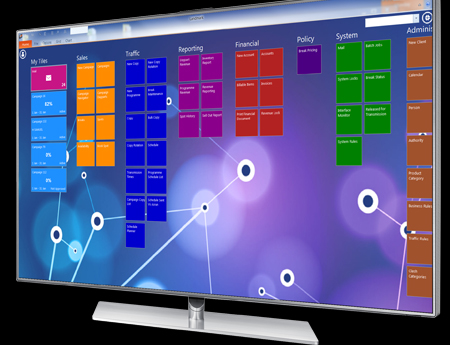Suppliers Jam on Traffic For Programmatic Tests

With programmatic advertising one of the hottest topics in marketing today, major suppliers of software that handle traffic, billing and sales operations are jumping on the bandwagon.
“I would say that the interest from our clients around digital programmatic automated selling tools has never been stronger,” says Eric Mathewson, founder and CEO of WideOrbit. The company recently partnered with Magna Global and Tribune Media to launch a programmatic buying system, WO Central, and announced that Hearst, Meredith, Raycom, Scripps and Sinclair will test the system at their stations.
The rush to embrace programmatic technologies that automate the buying and selling process and to provide much more targeted advertising capabilities is occurring as part a larger, ongoing push by vendors to provide a unified traffic, billing and sales systems for TV, VOD, online, mobile and other platforms.
“As a company, we’re spending almost $50 million between the acquisitions we’ve made and hiring we’re doing to build a complete digital solution,” adds Mathewson, who says WideOrbit has made several acquisitions of ad tech firms in a push to build a complete multiplatform solution. “Companies would love to have a single advertising record for all platforms and have one vendors that handles everything.”
Targeted Programs
The scale and urgency of those investments reflects widespread interest in testing and deploying advanced advertising systems, says Michael J. Mc- Guire, VP of MSA Media. “Companies are interested in using programmatic to better target audiences based on, say, age and sex,” he says. “They also want to be able to do that more efficiently and seamlessly with programmatic tools so they aren’t trading a lot of paper between agencies and programmers. So we are doing a lot of work to better automate that process.”
McGuire and others caution, however, that there remains a lot of confusion over how to apply programmatic advertising tools, which were first developed in the digital and online space, to the TV industry, where such deployments are still in their infancy.
Broadcasting & Cable Newsletter
The smarter way to stay on top of broadcasting and cable industry. Sign up below
“Frankly we haven’t yet seen the rapid move to programmatic buying that some have predicted,” says James Ackerman, executive chairman of Broadway Systems. He remains convinced, however, that such technologies will become more important in the future, and recently, Broadway Systems integrated their offerings with a major programmatic advertising system so their clients can test those tools.
Ackerman says programmatic is particularly attractive to smaller networks that aren’t as yet rated by Nielsen and by networks that might want to sell inventory in off-peak hours or for shows that don’t fit their primary demo. “It provides a way for them to attract more national ad dollars,” he says.
Cashing In on Deals
Broadway Systems is hardly alone as other major traffic, billing and sales vendors are pushing to expand programmatic efforts. Geoff Nagel, VP of go to market strategy for North America at SintecMedia explains that their 2014 acquisition of Pilat Media provided them with the basis for a complete multiplatform system.
As part of that push, the company is also developing a digital programmatic product. “It will connect ad buyers and sellers in a new sort of way,” says Nagel. “There is a lot of interest in that space but the challenge has been to figure out how the market will develop.”
Adam Roberts, director of media sales at Imagine Communications says that they have long been monitoring programmatic ad technologies and a few years ago developed a solution for one of their clients that is still being used. “We have a lot of experience with this space,” he says.
To further evolve those offerings, the company has hired a product manager with a background in programmatic advertising and is working on an attendant product that can be widely launched among its clients as part of its Landmark suite of products.
The company is also well along on a larger initiative to move their complete Landmark suites of broadcast products into the cloud. Last month at IBC, the company launched Landmark Express, a cloud-based suite of cost-effective advertising sales, rights and scheduling solutions for small and mid-size broadcasters.
Roberts stresses that these cloud-based products will make it much easier for clients to embrace newer programmatic ad technologies.
“It has been a big focus for us to bring all of our products into the cloud so that clients can develop new services in a cost-effi cient manner and avoid big capital costs they might have had in the past,” he says.
HELPING ADS GO WITH THE FLOW
THE AUTOMATION OF AD SALES via programmatic ad technologies is only one aspect of how vendors continue to work to streamline the process of selling and placing broadcast inventory into linear and on-demand feeds for TV and digital platforms.
Adam Roberts, director of media sales at Imagine Communications, notes that having both an automation product and a suite of traffic, billing and sales products has been a major advantage for them with the development of live logs. This both streamlines workflows and helps stations more efficiently use their inventory.
To help with the growing complexity of TV deals, Broadway Systems has streamlined the process of spot placement in its most recent release. “We have built more automation into the system to handle complex instructions and placement,” says James Ackerman, executive chairman of Broadway Systems.
To streamline workflows and to better exploit content, software systems to handle metadata is also crucial, explains Crist A. Myers, president and CEO at Myers. “If you want to leverage your content for dynamic ad insertion or better pair it up with advertisers, it all comes down to meta data,” says Myers, who adds that their “ability to manage content and meta data” will help clients take advantage of dynamic ad insertion and other advanced advertising systems that rely on metadata.
